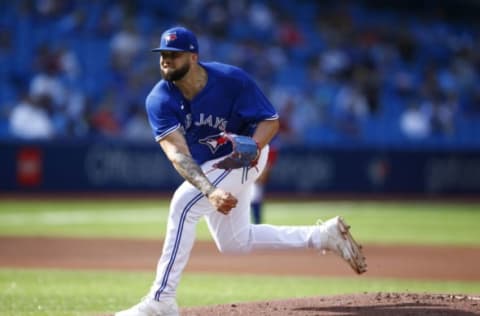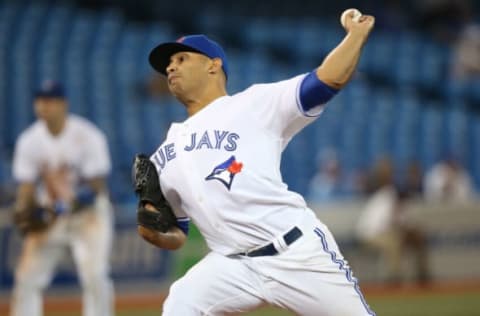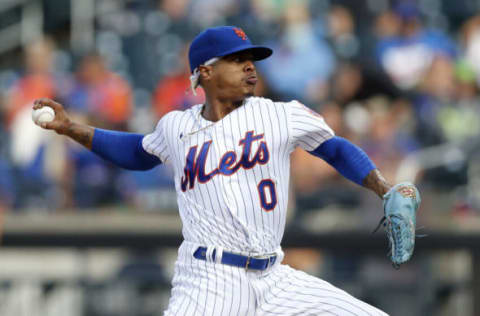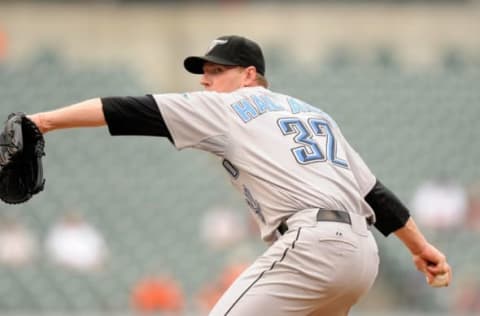Part 1: Comparing Alek Manoah’s rookie season to former Blue Jays pitchers


This season, the Blue Jays fanbase got to witness Alek Manoah on the big league stage, the club’s 11th overall selection back in 2019.
After a stellar junior year at West Virginia University, the Blue Jays selected the 6’6″ Florida product and the right-hander got right to work down in A ball, crafting a 2.65 ERA with the Vancouver Canadians while starting six games and striking out 27 batters in just 17.0 innings of work with just five earned runs allowed.
While Manoah would spend the 2020 campaign at the Blue Jays alternate training site, he would find a groove early this past season during Spring Training and would be almost untouchable down in AAA, starting three games and allowing only one earned run through 18.0 innings with 27 strikeouts, three walks, and a 0.556 WHIP.
He wouldn’t stay very long in the minors, with the Blue Jays needing him up in the big leagues with the various injuries to the pitching staff and Manoah did not disappoint. His debut would be against the New York Yankees in New York and he wouldn’t fold under the pressure, going six innings while striking out seven batters with just two hits and two walks, earning his first win with the Blue Jays in front of a raucous Yankees crowd.
The right-hander would continue to pitch well for the Jays in the rotation, finishing the year with a 3.22 ERA through 20 starts and 111.2 innings pitched with 40 walks, 127 strikeouts, a 10.2 K/9 innings, and a 1.048 WHIP. He would miss some time on the IL after slipping in the dugout and landing on his back in mid-July, missing roughly two weeks. Manoah also got his first suspension out of the way, courtesy of a Baltimore Orioles squad who didn’t appreciate him hitting Maikel Franco after allowing a few home runs prior to his at-bat, getting him tossed from the game and suspended for five more.
While Manoah most likely won’t win the Rookie of the Year award given he started the season in late May, the right-hander emerged as a potential centerpiece in the rotation for years to come, a notion that seemed only appropriate for fellow prospect Nate Pearson over the past two seasons. That being said, a full season of having the WVU alum on the mound for the Blue Jays could be a real difference-maker next season, especially if he can continue to build on his rookie campaign and keep his fiery attitude alive on the mound.
This begs the question – how does Manoah’s rookie season compare to former Blue Jays’ top pitching prospects during their rookie campaigns?
*For the purpose of this article, a pitcher’s rookie season will be designated as to when the player exceeded rookie limits as per Baseball Reference*

Ricky Romero
Rookie Season: 29 games; 178.0 IP; 4.30 ERA; 141 strikeouts; 1.522 WHIP
Ricky Romero was drafted by the Blue Jays in the first round of the 2005 MLB Draft at sixth overall. He would make his debut in 2009 as one of the club’s top pitching prospects and would put up pretty respectable numbers, trailing only Roy Halladay in terms of games started while holding his own against a tough AL East division that saw the New York Yankees win the World Series. He would pitch for five years with the Blue Jays, crafting a career 4.16 ERA with one all-star appearance before being sent to the minors in 2013, making only four appearances for the Blue Jays that year.
Romero has since retired from baseball after a few years trying to make it back to the major leagues outside of the Jays organization and a brief stint in the Mexican League.
After the great season Alek Manoah had, this article examines his rookie season compared to former Blue Jays pitchers, former prospects, and legends.
Crunching the Numbers
Comparison-wise, Manoah tops Romero in quite a few pitching categories such as ERA and WHIP but trailed in innings pitched and games started, mostly because the right-hander started his Blue Jays career in late May compared to the southpaw taking the mound in early April. Looking at some of the advanced pitching stats, Manoah also holds an edge over Romero in terms of K/9 (10.2 vs. 7.1) and BB/9 (3.2 vs. 4.0).
If Manoah had started the year with the Blue Jays at the beginning of April, he would have easily passed Romero in terms of strikeouts and would be nearing the left-hander in terms of innings pitched and games started. The Florida product does have the added benefit of starting his career with a pretty stellar supporting cast like Robbie Ray, Hyun Jin Ryu, and Steven Matz while Romero really only had Halladay, as the rest of the rotation paled in comparison with Brian Tallet and Scott Richmond the two best arms behind him in the rotation.

Marcus Stroman
Rookie Season: 26 games (20 starts); 130.2 IP; 3.65 ERA; 111 strikeouts; 1.171 WHIP
Drafted by the Blue Jays in the first round in the 2012 MLB Draft, Marcus Stroman was one of the top pitching prospects in the organization at the time of his debut and would have made his big league appearance earlier than the 2014 season if it wasn’t for the 50 game suspension he had to serve to begin the 2013 campaign for a banned stimulant.
Stroman would be called up to the Blue Jays in early May in a relief capacity before becoming a starter towards the end of the month, eventually making 20 starts for the club. The right-hander would pitch well alongside R.A. Dickey and Mark Buehrle that season, eventually becoming one of the Blue Jays top pitchers in the mid-2010s until being traded to the New York Mets at the 2019 trade deadline. For his career, the Duke alum sports a 3.63 ERA with 853 strikeouts through 1028.1 innings pitched and is currently a free agent heading into this upcoming offseason.
Crunching the Numbers
Manoah edges out Stroman in terms of ERA, with both players making the same amount of starts, although the former Blue Jays pitcher does have six relief appearances which puts him ahead in terms of total appearances and innings pitched. The 6’6″ righty also has the numbers in terms of strikeouts (127 vs. 111), WHIP (1.048 vs. 1.171), and H/9 (6.2 vs. 8.6) while Stroman has the advantage in terms of walks (28 vs. 40) and HR/9 (0.5 vs. 1.0).
Both pitchers were great for the Blue Jays in their rookie season and both have a lot of similarities, especially with their fiery personalities on the mound. While the relationship between Stroman and the Blue Jays would sour over time and eventually see the righty shipped out to the Mets, he recently stoked the fires by stating that he would be open to returning to the Jays, an idea that has fans still on the fence about at a potential reunion.

Roy Halladay
Rookie Season: 36 games (18 starts); 149.1 IP; 3.92 ERA; 82 strikeouts; 1.574 WHIP
Another first-round draft pick for the Blue Jays, Roy Halladay would become one of the top pitchers in franchise history, starting with his debut in 1998 and his rookie season in 1999. Noted for his work ethic, workhorse mentality, and off-the-field charity initiatives, Halladay was one of the biggest draws during some pretty rough seasons for the Blue Jays, earning six all-star appearances with one Cy-Young award during his 12 seasons with the organization. He was inducted into the Hall of Fame in 2019 and while he passed away in late 2017, Halladay will forever live in the franchise record books as one of the top pitchers in club history.
Halladay’s rookie season would be one where he saw action in both the rotation and the bullpen, starting the season as a relief pitcher before making a few starts and then bouncing between both roles to finish the campaign. While he did give up 156 hits and 79 walks, Halladay was able to limit the damage to 65 earned runs with 82 strikeouts and a 3.92 ERA.
Crunching the Numbers
Alek Manoah once again leads with his 3.22 ERA over Halladay’s 3.92 ERA, however, the former Blue Jay had a lot more appearances than the current right-hander, finishing with two fewer starts but 16 more outings overall when you factor in the relief innings. Surprisingly, Manoah has the edge in terms of strikeouts (127 vs. 82) despite Halladay having 37.9 innings over the Florida product, while Manoah also sports a superior WHIP (1.048 vs. 1.574). He also has the edge over Halladay in terms of home runs allowed (12 vs. 19), H/9 (6.2 vs. 9.4), and K/9 (10.2 vs. 4.9).
Arguably, Halladay wouldn’t really hit his stride until 2002, where he started becoming the workhorse that fans haven’t seen from a Blue Jays starter since he was traded away prior to the 2010 season, so a comparison between the two may not seem fair. Considering the legacy Halladay left behind, not only with the Jays but also with the Philadelphia Phillies, here is hoping Manoah can follow in his footsteps and potentially become one of the club’s top pitchers over the next 5-6 seasons.
dark. Next. Top 5 players most likely to be traded this offseason
Didn’t see a pitcher comparison you were hoping to see?
Part two coming soon.